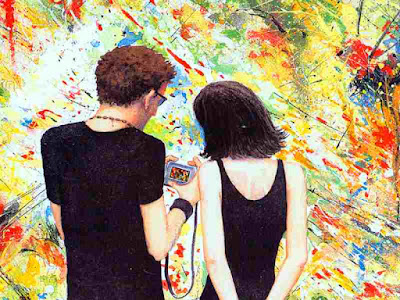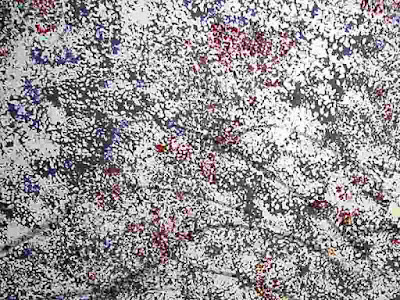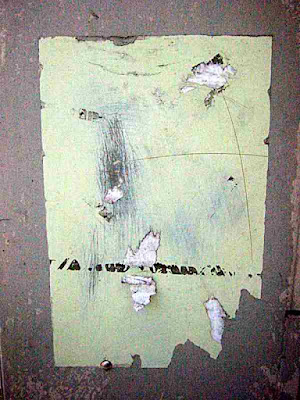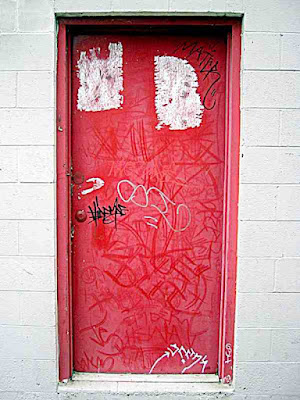It's been quite a while since I've seen either publication. Recently I wanted to read the Alex Ross New Yorker article about Esa-Pekka Salonen. I know Esa-Pekka personally because I've worked on most of his new music since the last millennium (well, since 1999) and even edited some of his pieces for publication.
My neighborhood Rite Aid (that's a drug store) has a huge wall of magazines so I figured I could walk up there and get a copy. I found no New Yorker. A clerk asked a supervisor "Do we carry a magazine called The New Yorker?" I inferred that he had never heard of it. Later I found my copy hidden on a top shelf at Vroman's, a local independent bookstore. I've read there are now more New Yorker subscribers in California than in New York.

In case you run across a stack of back issues and want to read this fine article, the cover shows a young hip couple wearing black standing in front of a huge ersatz Jackson Pollock action painting completely absorbed by the tiny video screen of the camera they have just used to photograph that very painting. I can relate to their motivation completely; they want to save the experience for later. The remaining illustrations in this article are various ersatz accidental modern art pieces that I have saved for later (i.e. now) from my trips to that great gallery space called Pasadena.
Anyway, old habits remain and I opened my new copy of The New Yorker from the back and skimmed forward reading the cartoons. There seemed fewer of them and some inside illustrations were in color and the type was bigger. Does bigger type mean an aging readership with deteriorating eyesight? Probably.

Alex Ross describes Esa-Pekka exceptionally well - I could attest to every description of his personality and behavior. I wondered about just one thing: that E-P would only know who Jabba the Hutt was via his young son Oliver. I've discussed science fiction with Esa-Pekka several times - although the conversation ranged more towards Lem than Lucas.
In the rest of the article Ross talks of our acoustically fine concert hall and the exceptional orchestra which inhabits it, of the recently announced change in music directorship here and how the orchestra's administration has made miracles happen. Ross, always the optimist, concludes that Esa-Pekka's tenure in Los Angeles "may mark a turning point in the recent history of classical music in America." Wow, I hope I live long enough to find out if that's true.
In one bizarre episode Ross follows a Philharmonic cellist through a busy day - commuting on a motorcycle, teaching the Elgar concerto, and taking an improvisation lesson in Laurel Canyon from a teacher who tells him to "find the magic in the intervals". Yeah, dude, far out. Californians are like that. Got any papers?

But in the entire article this one sentence was most interesting to me:
Perhaps (LA Philharmonic President & Executive Director Deborah) Borda's boldest notion is to give visiting composers such as (John) Adams and Thomas Ades the same royal treatment that is extended to the likes of Yo-Yo Ma and Joshua Bell; Borda talks about "hero composers."Ah yes. The "composer as hero" syndrome. I thought that was just a concept that I had come up with years ago to explain away the Philharmonic's tunnel vision of new music marketing. Apparently they do it consciously. Of course they do. Conscious or not, it predates the Borda years.
Over the years I've had the opportunity to watch this phenomenon both from a distance and from up close. The first hero composers that I remember in L.A. were Pierre Boulez and Wittold Lutoslawski. Back then I was producing concerts of alternative new music (i.e. an alternative to what happened at the Phil.). I think I would have given several important body parts for a performance of my music by the Philharmonic.

In my first years in Los Angeles new music was never programmed on the second half of Philharmonic concerts because a large portion of the audience would simply leave at intermission. In the late '80s I remember overhearing two subscribers discuss their least-favorite recent new music performances (an awful Mel Powell piece won hands down.) Once in the 90s, after John Adams had given a pre-concert lecture, I overheard a woman say "He seems like a very genuine person." And indeed he is. But so was Mel.
I'm not saying our music heroes don't deserve attention. But I feel strongly that the world of creative music should not be an all or nothing, winner take all place. There must be hundreds of composers in the US with the talent , experience, ideas and motivation for the job of Hero, if it were only offered. For whatever reason, very few are chosen. All four that I can think of in LA have already been mentioned here.

Selling composers as heroes works not because they are treated like soloists, as Alex Ross suggests, but because they are treated more like the classical gods, your Beethovens and your Wagners. My sense is that nineteenth century music sustains general interest in all classical music in this country. As a result we treat living composers by the standards we use for nineteenth century composers. It's a very top down arrangement. I've never liked it.
About the time of the movie Amadeus (1984) I got myself into a spot of difficulty when a local free newspaper quoted me calling the then composer-in-residence of the Philharmonic "the Salieri of new music in Los Angeles." What got back to this person was that I was accusing him of murder. (After that I was more careful to be specific about which interview comments were on the record and which not. By the way, that very reviewer has since won a Pulitzer prize.)
Back then I stayed on good terms with the composer by writing a letter to the paper explaining what I meant: that the composer-in-residence had great influence on deciding whose music was heard "at court" By "at court" of course I meant "at the Philharmonic". Now, 20 years on, Amadeus is pretty much forgotten and I've learned my lesson about making analogies.

These days I just compare the Philharmonic to an 800-pound gorilla. The analogy "at court" still works, however, and I even get to attend once in a while. By either analogy the Philharmonic is the only really big player in the local new music scene. The nearest competitor in the same weight class is the San Francisco Symphony. I've noticed that East Coast people tend to think San Francisco is much closer to L.A. than it really is, not just in distance but also in culture. Los Angeles is spread out over a huge geography - but it's not that big.
Finally, once Alex Ross finished his New Yorker article he wrote this in his blog: "You L.A. people are lucky." Yeah, probably so. But I'd like to suggest that he withhold judgment until he spends some time here during the months of August and September. That's when the sun burns your skin and the smog burns your eyes and the programming with fireworks at the only live classical music venue in town burns your soul.

Sign up for a free weekly New Yorker cartoon email here.
Paul Viapiano, also a Pasadena blogger, has this recent article about reading The New Yorker.
A previous Mixed Meters post - Los Angeles, New Music Backwater
Eustace Tilley Tags: The New Yorker. . . Esa-Pekka Salonen. . . Alex Ross. . . Los Angeles Philharmonic. . . new+music. . . composers. . . heroes. . . hero composers. . . John Adams. . . Thomas Ades. . . Pierre Boulez. . . Wittold Lutoslawski
No comments :
Post a Comment